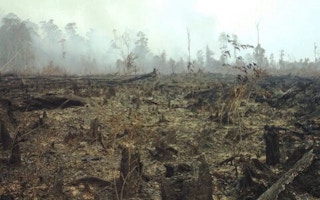A joint research of Indonesian and US scientists shows that peat fires in Central Kalimantan in Indonesia released less carbon dioxide than projected by UN climate experts but discharged more potentially hazardous gases.
The research, led by scientists from the Bogor Agricultural University, Palangka Raya University, Central Kalimantan and Kapuas administrations, Borneo Orangutan Survival Foundation, and the South Dakota State University and Montana University, was funded by NASA after massive peat fires struck the province in 2015.
Influenced by a strong El Niño, the peat fires deteriorated air quality to ten times the “very dangerous” threshold.
According to the research study published in the Atmospheric Chemistry and Physics journal, the carbon dioxide released was eight per cent less than the emission factor data by the UN Intergovernmental Panel on Climate Change (IPCC), which took samples of peat in Sumatra island and burned it in lab unlike the new study which took actual burned peats from the field. In 2003, scientists didn’t yet understand that the two sampling methods would make a difference. Methane release was also 55 per cent less than the IPCC emission factor data.
“The results, if compared with IPCC data, showed a significant gap so we are hoping that [the IPCC data] can be considered to be corrected,” says Bambang Hero Saharjo, a co-author of the study and lead scientist at Bogor Agricultural University.
Saharjo says they used a device called the Fourier transform infrared spectroscopy that is designed to collect smoke samples and identify up to 90 gases straight from the burned location.
“We collected smoke samples in Pulang Pisau district in Central Kalimantan. It was the same site President Jokowi visited to survey canal blockings,” he says. “The spectroscopy could immediately read and identify the gases in real time. We also collected soil samples from the burned location.”
“With the current study, Indonesia’s carbon emissions would be 19 per cent less than previously stated,” he says, adding it would be crucial to correct the country’s status as the world’s third largest carbon emitter because of forest and peat fires.
“
These gases are as important as methane and carbon dioxide, because if the air is polluted and contaminated, they can be harmful to people, especially pregnant women.
Bambang Hero Saharjo, Bogor Agricultural University
The study also picked up other gases related to ozone depletion as well as health risks, which are mostly unaccounted for when measuring greenhouse gas emissions. These major gas-phase air toxics and carcinogens include hydrogen, cyanide, formaldehyde, acrolein, acetamide, BTEX, crotonaldehyde and 1,3-butadiene.
“These gases are as important as methane and carbon dioxide,” says Saharjo. “Because if the air is polluted and contaminated, they can be harmful to people, especially pregnant women.”
Kirsfianti Linda Ginoga, director of greenhouse gas monitoring at Indonesia’s environment and forestry ministry, says the study would serve as a valuable input in determining Indonesia’s emission levels using different methods rather than just relying on hotspots from satellite images.
Emma Rachmawaty, director of climate change mitigation at the same ministry, adds it would be better if the results of the study can be included in the IPCC emission factor database to serve as reference for other nations with the same peat characteristics as Indonesia.
This piece was produced by SciDev.Net’s South-East Asia & Pacific desk.










